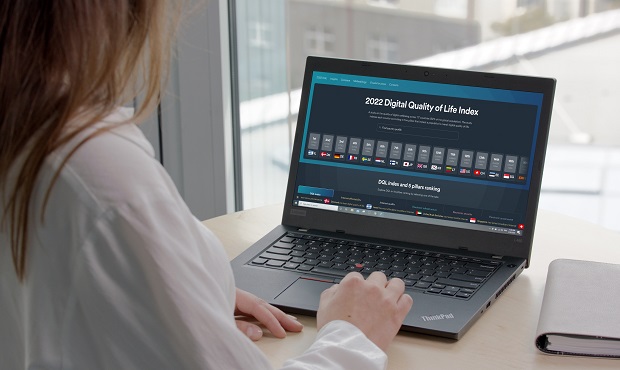The fourth annual edition of the Digital Quality of Life Index (DQL) has reported that the Philippines ranks 55th out of 117 countries in the world regarding digital well-being.

Out of the five fundamental digital life pillars, the Philippines’ worst score is for Internet affordability (ranking 98th globally), and the best is for e-security (44th).
The country’s Internet quality services came at 45th, while e-government and e-infrastructure ranked 62nd and 65th, respectively.
The DQL study is conducted by the cybersecurity company Surfshark. It evaluates countries based on five fundamental digital wellbeing pillars: Internet quality, e-government, e-infrastructure, Internet affordability, and e-security.
This year, the Philippines has made it into the top 60 globally, ranking 55th in the final index and 14th in Asia. The country has dropped by seven positions since last year’s edition, falling from 48th to 55th.
Out of all index pillars, the Philippines’ weakest spot is Internet affordability, which needs to improve by 4300% to match the best-ranking country’s result (Israel’s).
Internet quality in PH is comparatively mediocre
The Philippines’ Internet quality, considering Internet speed, stability, and growth, ranks 45th in the world and is around the same as the global average.
Regarding Internet speed alone, the Philippines’ fixed broadband Internet ranks higher than mobile in the global ranking, operating at 75.1 Mbps/s (55th globally). Meanwhile, the mobile Internet comes 61st (38.7 Mbps/s).
Compared to Indonesia, Philippines’ mobile Internet is 2 times faster, while broadband is 3 times faster. Since last year, mobile Internet speed in the Philippines has improved by 33% (9.6 Mbps), and fixed broadband speed has grown by 52.2% (25.8 Mbps).
In comparison, Singapore’s residents enjoyed mobile speeds up to 104 Mbps/s and fixed to as much as 261 Mbps/s — that’s the fastest Internet in the world this year.
Internet in PH not affordable
Philippines’s Internet affordability ranks 98th in the world. Residents can buy 1GB of mobile Internet in the Philippines for as cheap as 4 minutes 51 seconds of work per month, 21% more than in Indonesia.
However, compared to Israel, which has the most affordable mobile Internet on the planet (5s per 1GB), Filipinos work 59 times more. Its affordability improved since the previous year, making people work 27 minutes 3 seconds less to afford the same mobile Internet service.
Fixed broadband costs Filipino citizens around 11 hours 5 minutes of their precious working time each month. To afford it, Filipinos have to work 34 times more than Israeli citizens, for whom the most affordable package costs only 19 min of work monthly.
Since last year, broadband Internet has become less affordable in the Philippines, making people work 6 hours 4 minutes more to afford fixed broadband Internet service.
Global digital divide now deeper than ever
Globally, broadband is getting less affordable each year. Looking at countries included in last year’s index, people have to work six minutes more to afford broadband Internet in 2022.
In some countries, such as Ivory Coast and Uganda, people work an average of 2 weeks to earn the cheapest fixed broadband Internet package.
The same trend was observed last year. With the current inflation, the pressure on low-income households that need the Internet has become even heavier. The study also found that countries with the poorest Internet connection have to work for it the longest.
“While countries with a strong digital quality of life tend to be those of advanced economies, our global study found that money doesn’t always buy digital happiness,” said Gabriele Racaityte-Krasauske, head of PR at Surfshark.
“That is why, for the fourth year in a row, we continue analyzing the Digital Quality of Life to see how different nations keep up with providing the basic digital necessities for their citizens. Most importantly, our research seeks to show the full picture of the global digital divide that millions of people are suffering from.”
Best and worst countries to live
Overall, 7 out of 10 highest-scoring countries are in Europe, which has been the case for the past three years.
Israel ranks first in DQL 2022 pushing Denmark to the second place after its two-year lead. Germany ranks 3rd, and France and Sweden round up the top five of the 117 evaluated nations. Congo DR, Yemen, Ethiopia, Mozambique, Cameroon are the bottom five countries.
Regionally, the US stands out in the Americas as a country with the highest digital quality of life, while Israel takes the leading position in Asia.
Among African countries, people in South Africa enjoy the highest digital life quality. In Oceania, New Zealand takes the lead outperforming Australia in various digital areas this year.




